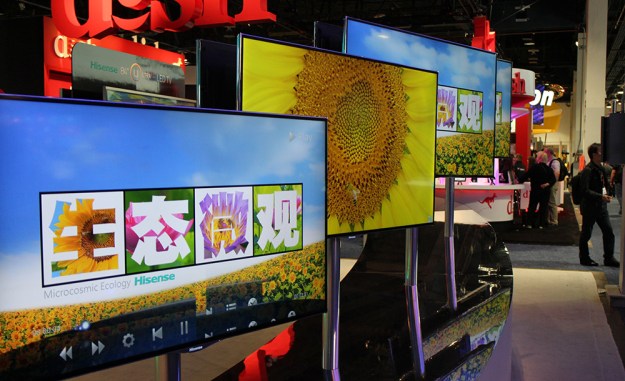
The biggest trend of the 2013 Consumer Electronics Show, which concludes today, is not Ultra High Definition TVs, connected appliances, or oversized smartphones. It is the rise of the Chinese brands – Hisense, Haier, Huawei, ZTE, TCL, and countless others – many of which pumped up their presence at this year’s CES with Lance Armstrong-level enhancements.
Hisense led the Chinese pack with 9,600 square feet of prime show floor real estate historically inhabited by (conspicuously absent) Microsoft. Gadget maker TCL also made its big debut in the Central Hall of the Las Vegas Convention Center, with a massive, multi-colored booth that overwhelmed those around it, both in size and crowds. In the South Hall, Huawei, the world’s largest telecommunications manufacturer, and ZTE, the world’s fourth-largest mobile phone maker, flexed their marketing might with giant, gleaming-white booths and throngs of pretty people to show off their arrays of smartphones.
The collective message is clear: China wants to take the throne left by Japan and currently occupied by Korea – to strip away its reputation as the source of cheap ripoffs and become a presence in the technology lives of Americans like never before. But is that even possible? And if it is, what will it take to get there?
“Some of the guys in the press have said, ‘Oh, they think they can come in, take the Microsoft space, write a big check to CES, and all of a sudden, tomorrow, they’re a brand.’ That’s not our strategy at all,” said Chris Porter, product manager for Hisense U.S.A. “Our strategy here is to iterate the Hisense core values, and let people know that we’re a technology company, not just a low-cost manufacturer.”
To this end, Hisense – which debuted new 4K, 3D, and Google TV televisions at CES – plans to shift focus from its budget brands, Dynex and Insignia, and put its might behind the Hisense name. The same goes for Huawei, ZTE, and TCL, all of which hope to become household names in the U.S. And that means making great products.
“We recognize that we need to deliver a product that’s desirable and of the right form factor and make; and then, of course, a product that is of good quality and lasts,” said ZTE Product Planning Director Drew Wilken. “So definitely quality is one of our three key tenets.” Customization and affordability fill out the remaining two slots, Wilken said, while showing off the company’s new 5-inch Grand S Android handset on the CES show floor.
TCL made its big splash at this year’s CES with a 110-inch 4K 3D TV, dubbed the “China Star,” which launched with a tie-in to Marvel’s Iron Man 3 that included a man wearing a realistic Iron Man costume. But it’s not the theatrics that matter; it’s the products. On that point, the company says that it already has the quality part covered, and will focus on a low-and-slow rollout to build up its presence in the U.S. market.
“This is a great time to come in,” said TCL Director of Marketing Tom Heffenman. “I mean, nobody knows who we are, so [we] kind of have to come in at a lower end.”
The needs of U.S. consumers are simple, says Heffernman, and TCL believes it has precisely the bargain to fill that gadget void. “They’re looking for affordable, big screen TVs. And TCL not only has that, but they have incredible quality behind it,” he said. “[Consumers] don’t know that at this point. They think they’re just getting a no-name TV. But I think they will be won over.”
While basking in the glow of the China Star, I ran into Aaron Gieser, who runs a high-end home entertainment installation business out of his Southern California home. He said his customers are almost exclusively “super-rich people” – the only customers who actually buy the absurdly priced TVs we’ve been hearing so much about – and he was on the lookout for new inventory. I asked what he thought of TCL’s showcase.
“It looks good,” he said. “The only thing I’ve seen at the whole show is that everybody cares about thinner, apps, and all the bullshit. But nobody cares about picture qualiy. And from the few things that I’ve seen in [TCL’s] booth, so far the picture quality is – not perfect – but it’s a skosh better on the motion things.”
And that’s key – the Chinese brands really did show off some impressive products at CES. According to technology analyst Rob Enderle, “the Chinese products were some of the highest quality at the show.”
“I thought the Chinese vendors nearly owned the show this year,” said Enderle in an email. “Huawei had the most interesting smartphone line, and Hisense took Microsoft’s premier spot next to Intel.”
Consumer technology expert David Elrich, who has attended CES for more than 25 years, agreed that the Chinese impressed this year, but believes they still have a long ways to go before we can call it a win.
“These Chinese companies have made tremendous advances in technology and this is readily evident at this show,” said Elrich. “That said, their products are not nearly as good as the Korean versions. They can say they’re there, but there’s still a big gap.”
Regardless of whether the Chinese brands dominated CES, doing so does not make a company successful in the tough U.S. consumer electronics market. That road is much longer, the tolls are incredibly high, and it takes a skilled driver to navigate the twisties. Right now, it’s not clear that any of the Chinese companies will reach the destination alive.
The main difficulty, says Elrich, is that Chinese companies are clueless when it comes to successfully marketing in the U.S. “There is a problem I don’t know if they’ll ever overcome: They are not effective marketing companies,” he said. And if they don’t overcome it, “they will never be a Sony, never be a Samsung.”
Enderle completely agrees: Chinese brands will only succeed in the U.S. “if they learn to market in the Western world like Samsung did,” he said. “Currently, they don’t appear to be on the path to success.”
This bear outlook is hardened by the fact that big Chinese brands have built themselves up in a market where they have an unfair advantage: Both Huawei and ZTE have close ties to China’s communist government; Hisense is, literally, owned by it. According to Elrich, this protected position has instilled a confidence in these companies’ leadership that will shatter under the blinding glare of a free market.
“They are insular and stubborn beasts,” said Elrich. “They really think they have the ability to beat these other companies. They have hubris.”
Marketing is not the only area where these companies are lacking. To truly compete, they will have to beef up their technological advancements. And that means pouring truck-loads of money into their own research and development – something many are not doing.
“Until they get to the point where they spend massive amounts on R&D, they’re never going to be a world-class player,” said Elrich. And that means setting aside at least 5 percent of annual revenue toward building their proprietary arsenals.
Difficult though it may be, all is not lost for the Chinese. And we know this because Samsung was in the same position they are today, not that long ago. During the 1970s and ’80s, Samsung was a “garbage brand,” says Elrich. But then, in the late 1990s, the company got serious about making Samsung a force in consumer tech. It ditched its low-rent subsidiaries, like Samtron, and poured unfathomable resources into R&D and marketing. Today, Samsung has overtaken Sony to become the number one consumer electronics brand in the world.
It is the story of Samsung from which the Chinese brands must learn. Of all the companies I spoke with at CES, Hisense, which brought in $600 million in U.S. sales last year, seems to understand this best.
“We have a realistic three-, five-, and ten-year plan to move this brand from what’s considered to be a best-in-class tier-three price-point brand today to a tier two to a recognized tier one,” said Hisense’s Porter. And each step includes following the trail blazed by Samsung – by cutting off the belly fat of its low-end brands, pumping 5 percent per year into R&D, loading up on patents, pleasing retail partners, and pushing the Hisense name with fiery passion around the U.S. It’s a process Hisense seems to realize will take time and patience.
“We’re a humble brand,” Porter said. “We just can’t come in and immediately take position in market share. We can take market share with price. But then we’re not profitable. And what happens? We’re gone. We’ve seen that from other Chinese manufacturers that come into the United States: Here today, gone tomorrow.”
While some of these companies may disappear overnight, it will take much longer for Hisense, or any other Chinese brand, to achieve its U.S. aspirations. But such a rise could very well happen, just as the Japanese brands stole the crown from the U.S., and the Koreans stole the crown from Japan. And one day, perhaps at the opening of CES 2023, China could pull a coup d’état of its own.
Never forget, said Porter, “history repeats itself.”
Editors' Recommendations
- Digital Trends’ Top Tech of CES 2023 Awards
- What to expect from smartphone makers now that MWC 2020 is canceled


